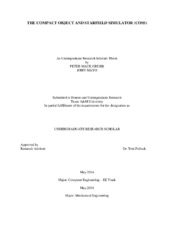| dc.creator | Grubb, Peter Mack | |
| dc.date.accessioned | 2015-06-30T14:02:20Z | |
| dc.date.available | 2015-06-30T14:02:20Z | |
| dc.date.created | 2013-05 | |
| dc.date.issued | 2013-02-15 | |
| dc.date.submitted | May 2013 | |
| dc.identifier.uri | https://hdl.handle.net/1969.1/154472 | |
| dc.description.abstract | As objects continue to be placed into space, Earth orbiting debris are becoming a prominent issue. To counteract this, NASA’s Marshall Space Flight Center’s (MSFC) Engineering Directorate has funded a project to create a test bed for systems designed to track and identify said objects, known as a starfield simulator. This system generates 2D images and displays them for viewing by potential optics being considered for Earth orbiting debris detection systems. One method studied previously for identifying objects is the Fine Scale Optical Range (FiScOR)[1], a method for physically modeling space objects at a distance using 3D printing and then recording light curves; however, this system did not consider physical objects in the context of an actual starfield. Thus the goal of this proposed research is to develop a system which allows for the gathering of FiScOR type physical object light curves in the context of a starfield simulator such as the one funded by NASA’s MSFC. | en |
| dc.format.mimetype | application/pdf | |
| dc.subject | Compact Object and Starfield Simulator | en |
| dc.subject | COSS | en |
| dc.subject | NASA | en |
| dc.subject | Marshall | en |
| dc.subject | Fine Scale Optical Range | en |
| dc.subject | FiScOR | en |
| dc.subject | Optics | en |
| dc.subject | Simulation | en |
| dc.title | THE COMPACT OBJECT AND STARFIELD SIMULATOR (COSS) | en |
| dc.type | Thesis | en |
| thesis.degree.department | Electrical and Computer Engineering | en |
| thesis.degree.discipline | Computer Sci. & Engr | en |
| thesis.degree.grantor | Honors and Undergraduate Research | en |
| dc.contributor.committeeMember | Pollock, Tom | |
| dc.contributor.committeeMember | Hill, Charles | |
| dc.type.material | text | en |
| dc.date.updated | 2015-06-30T14:02:20Z | |


